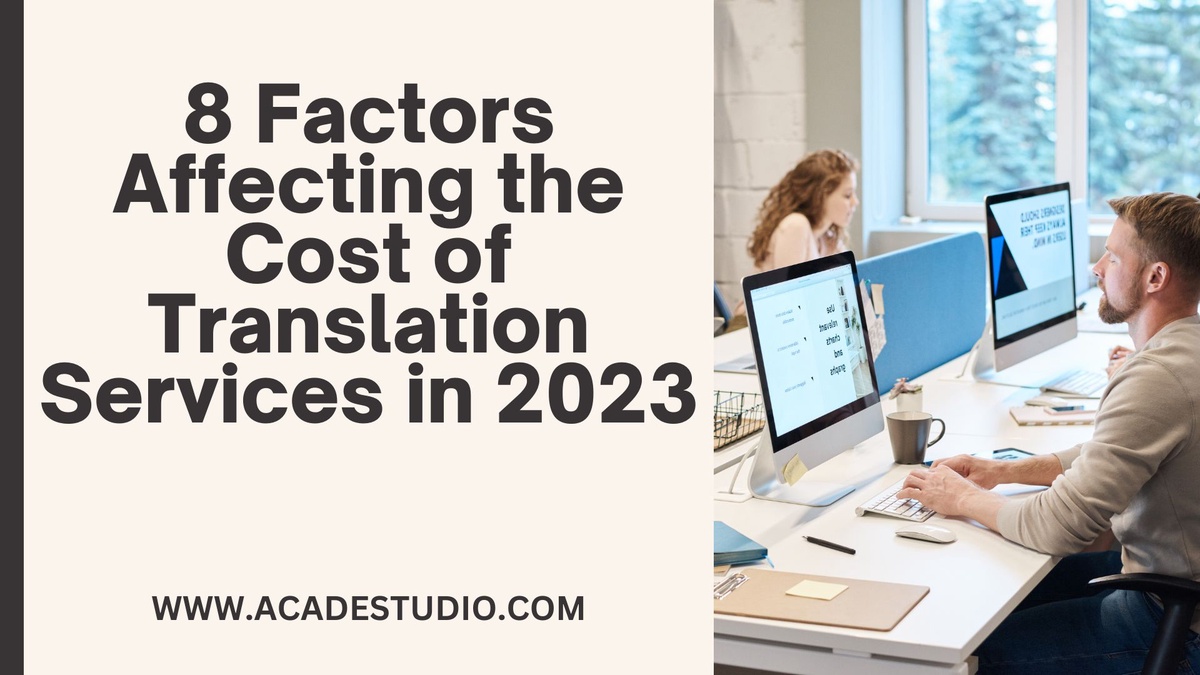The cost of translation services in 2023 is a multi-faceted concept influenced by many factors. Understanding these variables is crucial for businesses and individuals investing in translation services. This blog post delves into eight key elements that significantly impact translation costs: the complexity of the source material, language pair, translator's experience and expertise, deadline, the volume of work, need for additional services, quality assurance procedures, and market demand and supply. With this knowledge, you can make informed decisions and efficiently manage your translation budget. Let's explore each factor in detail.
1. The Complexity of the Source Material
The complexity of the source material forms a decisive factor in estimating the cost of translation services. Texts vary greatly, from simple, straightforward articles to complex scientific research papers or legal documents. Logically, these various degrees of complexity necessitate different levels of effort from the translator.
The technical or specialized nature of some documents requires translators with industry-specific knowledge. This knowledge enables them to translate technical jargon and context-specific phrases accurately. Naturally, such translators are harder to find and often demand a higher rate for their expertise. Therefore, the more technical the source material, the higher the translation cost.
On the other hand, straightforward texts with everyday language and widely understood concepts require less specialized knowledge. Any professional translator can handle such tasks with relative ease. As such, these tasks come with a lower price tag. It's worth noting that the content's complexity indirectly affects the time to complete the project, another factor influencing the cost.
2. Language Pair
Language pair combines the source and target languages in a translation project. The cost of translation services fluctuates greatly depending on this factor. Common language pairs, such as English to Spanish or French to German, usually offer lower prices. The reason behind this is the availability of translators specializing in these combinations, leading to more competitive rates.
However, translations involving rare or less common language pairs tend to cost more. Fewer translators work with these languages, reducing competition and increasing prices. Furthermore, these rare languages often involve unique cultural nuances and linguistic intricacies, necessitating specialized skills and knowledge.
This principle also extends to dialects within widely spoken languages. Certain dialects are less common and, thus, more costly to translate. When considering language pairs, it is essential to remember these nuances.
3. Translator's Experience and Expertise
The level of a translator's experience and expertise significantly influences the cost of translation services. Translators who have honed their skills over many years or across numerous projects often charge more for their services. Their extensive experience enables them to provide translations of higher quality and accuracy, thus justifying the higher cost.
Expertise refers to a translator's proficiency in a particular field or subject matter. Translators with specific areas of expertise, such as law, medicine, or technology, often charge more. Their deep understanding of the field allows them to translate industry-specific jargon accurately and provide contextually correct translations.
Cultural knowledge also falls under expertise. Translators who have a profound understanding of the cultural nuances of the target language can deliver translations that resonate with the intended audience. This capability is particularly crucial for marketing and localization tasks. However, acquiring such expertise takes time and experience, contributing to the higher cost of these services.
4. Deadline
One crucial element affecting translation costs is the deadline. The translation services often escalate in price when there's a pressing timeline. The reasoning behind this is simple. Translators have to accelerate their work pace, sometimes working extra hours or over the weekend, to ensure the project's timely completion.
However, a careful balancing act is required here. While a fast turnaround time might be essential for some projects, the speed must not compromise the quality of the translation. Rapid work can sometimes lead to mistakes or oversights, which may eventually require correction or revision, indirectly increasing costs.
If you possess the luxury of time, consider extending the deadline. Translators can work more flexibly, reducing the risk of errors. Consequently, you can save on unnecessary correction costs, ensuring a high-quality translation within a reasonable budget.
5. Language Pair
Language pairs contribute significantly to the pricing of translation services. The supply and demand for translators specializing in specific languages dictate the cost. Pairs like English-Spanish or English-French are common, with numerous translators available. As a result, competition among translators for these languages can keep costs relatively low.
On the other hand, less common language pairs or those involving less widely spoken languages tend to be more expensive. For instance, translating a document from English to a less common language like Basque or Icelandic may cost more. Fewer translators specialize in these languages, reducing competition and driving prices up.
Moreover, certain dialects or regional variations can affect translation costs even within commonly spoken languages. Understanding the dynamics of language pairs and how they interact with market forces is essential for accurate budgeting.
6. The Volume of the Work
Volume, or the total amount of text to be translated, directly impacts the cost of translation services. Logically, the more text there is, the more work is involved; thus, the higher the overall cost will be.
However, this doesn't mean that translating a larger text volume will necessarily break the bank. Many translation services offer volume discounts for larger projects. This price reduction often happens because the initial setup and project management costs are distributed across a larger word count, effectively reducing the cost per word.
But it's important to remember that a high-volume project with a tight deadline might cost more. The need for extra translators to manage the workload quickly could drive up the price. Thus, careful planning and a realistic timeline can help optimize costs, balancing the volume of work and the deadline.
7. Quality Assurance Procedures
Quality assurance procedures are an integral part of the translation process, significantly impacting the cost of services. Companies that emphasize robust quality checks often charge higher prices. These additional costs ensure the precision and accuracy of the translation, which can be of high value to clients.
This process typically involves several steps. First, the translation undergoes an initial review by a second translator or editor to check for errors and inconsistencies. Then, it may go through a final proofreading phase to ensure a flawless end product. In certain cases, it might also undergo localization testing to ensure the translation fits the cultural context of the target audience.
While this process adds to the cost, it also substantially increases the quality of the end product. Paying for thorough quality assurance procedures can be a worthwhile investment for businesses and organizations where precision and brand reputation is vital.
8. Market Demand and Supply
The market demand and supply principle applies to the translation industry, influencing the cost of services. Professional translation services costs can spike during periods of high demand, such as global conferences or major events. An increase in demand often stretches resources thin, leading to higher prices.
On the other hand, during periods of lower demand or a surplus of translators, prices can drop due to competition. When many translators are available, they compete for business, which can drive prices down.
It's essential to consider these market dynamics when planning for translation services.
Understanding when demand might be high or when there's likely to be a surplus of translators can help you budget effectively and avoid unexpected cost increases.
Wrapping Up
The translation service cost in 2023 hinges on multiple factors. These include source material complexity, language pair, translator's expertise, timeline, work volume, and market supply and demand interplay. Understanding these can aid in making informed decisions and aptly planning translation budgets. But it's vital to keep quality at the forefront, for cutting corners on translation can yield adverse results. Always remember a precise, high-quality translation can significantly contribute to your business success, making it a worthwhile investment. Ultimately, finding the right balance between cost and quality is the key to effective translation management.


No comments yet